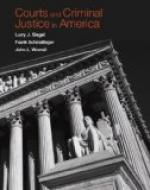Let us return, however, to that point in the proceedings where the defendant has been “held for trial” by the magistrate. The prisoner’s counsel now endeavors to convince the district attorney that “there is nothing in the case,” and continues unremittingly to work upon the feelings of the complainant. If he finds that his labors are likely to be fruitless in both directions, he may now seek an opportunity to secure permission for his client to appear before the grand jury and explain away, if possible, the charge against him.
We will assume, however, that, in spite of the assiduity of his lawyer, the prisoner has at last been indicted and is awaiting trial. What can be done about it? Of course, if the case could be indefinitely adjourned, the complainant or his chief witness might die or move away to some other jurisdiction, and if the indictment could be “pigeon-holed” the case might die a natural death of itself. Indictments, however, in New York County, whatever may be the case elsewhere, are no longer “pigeon-holed,” and they cannot be adequately “lost,” since certified copies are made of each. The next step, therefore, is to secure as long a time as possible before trial.
Usually a prisoner has nothing to lose and everything to gain by delay, and the excuses offered for adjournment are often ingenious in the extreme. The writer knows one criminal attorney who, if driven to the wall in the matter of excuses, will always serenely announce the death of a near relative and the obligation devolving upon him to attend the funeral. Another, as a last resort, regularly is attacked in open court by severe cramps in the stomach. If the court insists on the trial proceeding, he invariably recovers. Of course, there are many legitimate reasons for adjourning cases which the prosecution is powerless to combat.
The most effective method invoked to secure delay, and one which it is practically useless for the district attorney to oppose, is an application “to take testimony” upon commission in some distant place. Here again it must be borne in mind that such applications are often legitimate and proper and should be granted in simple justice to the defendant. Although this right to take the testimony of absent witnesses is confined in New York State to the defendant and does not extend to the prosecution, and is undoubtedly often the subject of much abuse, it not infrequently is the cause of saving an innocent man.
An example of this was the case of William H. Ellis, recently brought into the public eye through his connection with the treaty between the United States Government and King Menelik of Abyssinia. Ellis was accused in 1901 by a young woman of apparently excellent antecedents and character of a serious crime. Prior to his indictment a colored man employed in his office (the alleged scene of the crime) disappeared. When the case was moved for trial, Ellis, through his attorneys,




